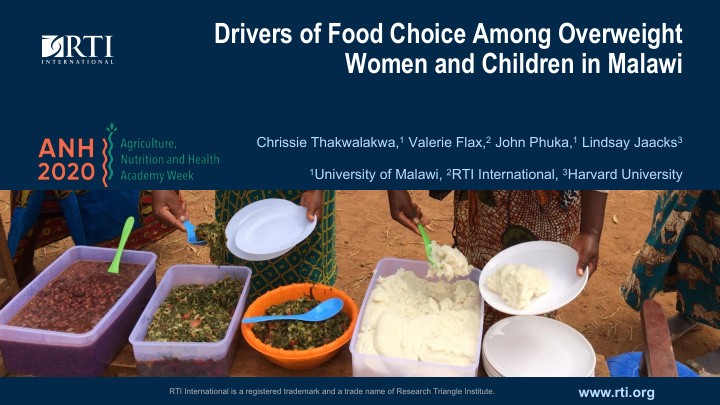



Drivers of Food Choice Among Overweight Women and Children in Malawi Chrissie Thakwalakwa, 1 Valerie Flax, 2 John Phuka, 1 Lindsay Jaacks 3 1 University of Malawi, 2 RTI International, 3 Harvard University www.rti.org RTI International is a registered trademark and a trade name of Research Triangle Institute.
Background Malawi § 21% mothers overweight/obese § 5% children <5 years overweight/obese 2
Study Design (n=274 dyads) Type of dyad Rural (n=37) Data collection tools: Urban (n=37) • Quantitative food frequency 74 questionnaire • Drivers questionnaire Rural (n=57) Urban (n=63) 120 Study sites: • 8 communities in Lilongwe and Kasungu Districts Rural (n=42) Urban (n=38) 80 3
Descriptive Framework Structural & Socioeconomic • Transport and distance to COST markets Gender • Amount spent on food • Who purchases food • Household food insecurity • Household decision- • Household assets making (female • Household water and toilet autonomy score) Food Choice facilities • Number of household Procurement members Consumption Taste Preferences • Number of children < 5 y • Maternal taste • Mother’s age • Mother’s education level preferences • Child’s age and sex • URBAN/RURAL • SEASON Cognitive SEASON • Body size preferences 4
Comparison of Dietary Intake of Mothers and Children by Study Arm vs. % calories from carbs Mother % calories from fat grams/day of grains % calories from carbs % calories from fat Child grams/day of oil/fat 5
Significant Predictors of Food Group Consumption in Mothers Vegetables Meat/Eggs Legumes/ Oils/Fats Snacks Sweets Roots/ Tubers Grains Dairy Nuts Fruit Fish Overweight mother, normal weight child vs. both overweight Number of household assets Household food insecurity access score Other family member usually buys food Uses transport to get to market vs. walking Purchase special foods for children Amount spent on special foods for children Mother perceives overweight/obese body size as healthy for her child Mother’s taste preference 6
Significant Predictors of Food Group Consumption in Children Vegetables Meat/Eggs Legumes/ Oils/Fats Snacks Roots/ Sweets Tubers Grains Dairy Fruit Nuts Fish Child age Mother has secondary education or higher Kasungu district vs. Lilongwe Number of household assets Household food insecurity access score Amount spent on food weekly Both parents usually buy food Purchase special foods for children Mother perceives overweight/obese body size as healthy for child Mother prefers obese body size for herself Mother’s taste preference 7
Conclusions Key drivers of food choice were: § Socioeconomic factors § Body size preferences § Taste preferences Recommendations: § Government of Malawi can use these findings to develop food policies or nutrition programs to emphasize factors positively associated with consumption of healthy food groups 8
Funding Disclosures No conflicts to disclose. Study Team Funded by the UK Government’s Department for International Development and the Bill & Melinda Gates Foundation, and managed by the University of South Carolina, Arnold School of Public Health 9
Recommend
More recommend